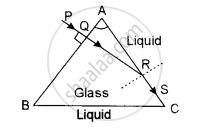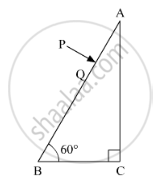Advertisements
Advertisements
प्रश्न
A narrow beam of monochromatic light, PQ, is incident normally on one face of an equiangular glass prism of refractive index 1.45. When the prism is immersed in a certain liquid, the ray makes a grazing emergence along the other face (See figure). Find the refractive index of this liquid. 
उत्तर
When the prism is immersed in the liquid and the incident ray emerges along AC, it is clear that it must be incident at the critical angle C on the face AC.
∠A + ∠ARQ = ∠C + ∠ARQ
From the figure, ∴ ∠C = ∠A = 60°
The critical angle when the prism is immersed in the liquid is 60°.
If μg is the refractive index of the material of the prism w.r.t. liquid
Then `""^l µ_g = 1/sin"C" = 1/sin60° = 1/(sqrt3/2) = 2/sqrt3`
`""^l µ_g = 2/sqrt3`
Also, we know that `""^l µ_g =( ""^aµ_g)/( ""^aµ_l)`
`""^aµ_l =( ""^aµ_g)/( ""^l µ_g )`
= `1.45/2 xx sqrt3`
= 1.45 x 0.866
= 1.256
APPEARS IN
संबंधित प्रश्न
A ray PQ incident normally on the refracting face BA is refracted in the prism BAC made of material of refractive index 1.5. Complete the path of ray through the prism. From which face will the ray emerge? Justify your answer.

State any two difference between the primary rainbow and secondary rainbow
For any prism, prove that :
'n' or `mu = sin((A + delta_m)/2)/sin(A/2)`
where the terms have their usual meaning
Give the formula that can be used to determine refractive index of materials of a prism in minimum deviation condition ?
A prism can produce a minimum deviation δ in a light beam. If three such prisms are combined, the minimum deviation that can be produced in this beam is _______________.
A certain material has refractive indices 1.56, 1.60 and 1.68 rfor red, yellow and violet lightespectively. (a) Calculate the dispersive power. (b) Find the angular dispersion produced by a thin prism of angle 6° made of this material.
The minimum deviations suffered by, yellow and violet beams passing through an equilateral transparent prism are 38.4°, 38.7° and 39.2° respectively. Calculate the dispersive power of the medium.
Two prisms of identical geometrical shape are combined with their refracting angles oppositely directed. The materials of the prisms have refractive indices 1.52 and 1.62 for violet light. A violet ray is deviated by 1.0° when passes symmetrically through this combination. What is the angle of the prisms?
The deviation produced for violet, yellow and red lights for crown glass are 3.75°, 3.25° and 2.86° respectively. Calculate the dispersive power of the crown glass.
Define angular dispersion.
